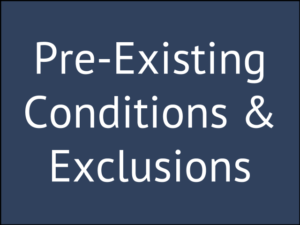
A pre-existing condition limitation period or an exclusion is a clause in an insurance contract that an insurance company uses to avoid paying for conditions you had before you were covered under a new policy. Since employees are often confused by how these clauses affect them, I wanted to talk about what pre-existing condition limitations and exclusions are in insurance policies and how they work.
The passage of the Affordable Care Act, which doesn’t allow insurance companies to turn people down because of a pre-existing condition for health insurance, has led people to believe that this also prohibited insurance companies from having any pre-existing condition limitations or exclusions in all policies.
But, that’s not the case.
The Affordable Care Act only applies to pre-existing conditions related to being approved for a health insurance policy. It doesn’t apply to other forms of insurance such as disability income insurance or critical illness insurance which both routinely contain these clauses in their policies. It also doesn’t apply to life insurance policies which might be offered at work that require underwriting.
Pre-existing conditions, or “Pre-Exes” as they are called in the insurance business are alive and well in other types of policies.
What this means is that a pre-existing condition can affect whether you are approved for these other types of policies or if you are approved, whether you will receive payment out of a policy on claim related to a pre-existing condition.
Once you are approved for a policy, insurance companies deal with pre-existing conditions in one of two ways. Those are:
- Pre-Existing Condition Exclusion An exclusion prevents any payment from a policy due to a pre-existing condition. As an example, a critical illness policy I looked at recently listed cancer as one of its covered conditions. However, if you had previously already had cancer, then the policy would never ever pay for cancer if you got cancer again. It would exclude cancer. However, while it might exclude cancer, it might still pay for a heart attack, or any other covered condition, it you never had that condition before (subject to any pre-existing condition limitation).
- Pre-Existing Condition Limitation A pre-existing condition limitation prevents payment from a policy if a claim due to pre-existing condition if it happens during a certain window of time – like 12 months. An example would be if you a history of heart problems and had a critical illness policy that covered heart attacks and you had a heart attack in the first 12 months – then no payment would be made.

I want to get Critical Illness Insurance but it has a clause of-Pre-Existing condition Limitation: not applicable. What does that mean?
If I understand your question correctly, it would mean that there is no pre-existing condition clause which would be a good thing. Verify that with the people who are offering the program to be sure and keep your paperwork where it says that with your records as well.
I’m looking at a Pre-ex with 12/6. Does that mean they look back 6 months for preexisting conditions? And if there are any preexisting within that 6 mo. period they will not cover that particular condition? What’s the 12 mean then?
A 12/6 pre-ex means that if you have a claim during the first 6 months after the effective date of your policy, they will look back 12 months before the effective date to see if you had a pre-existing condition that might have caused your claim. If so, they can deny the claim. After 6 months go by after the effective date, they would no longer look back.